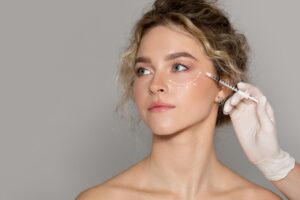 Restoring facial volume can create a smoother, more youthful appearance, and there are several ways to achieve this. Facial fat grafting and dermal fillers are two widely used options that address volume loss with different methods and outcomes.
Restoring facial volume can create a smoother, more youthful appearance, and there are several ways to achieve this. Facial fat grafting and dermal fillers are two widely used options that address volume loss with different methods and outcomes.
Dr. Saul R. Berger, a board-certified plastic surgeon with over 25 years of experience, offers both treatments as part of his personalized cosmetic approach. Trained at The Mount Sinai School of Medicine and USC, he combines surgical expertise with an eye for natural-looking results.
Understanding how fat grafting and dermal fillers compare can help you decide which option may be the right fit for your goals.
What is Facial Fat Grafting?
With fat grafting, a patient’s own fat is used to naturally replenish volume in the face. The process involves removing fat from another part of the body, refining it, and placing it into areas that often appear hollow or sunken, such as:
- Cheeks
- Temples
- Nasolabial folds (the lines that run from the nose to the corners of the mouth)
- Under-eye hollows
- Jawline
The use of natural fat helps fat grafting blend seamlessly with existing facial features, producing a softer and more organic look. The results can be long-lasting, as some of the fat cells become a stable part of the facial contour.
How Dermal Fillers Work
Dermal fillers are injectable treatments made from hyaluronic acid or other biocompatible materials designed to add volume and smooth out facial lines temporarily. These fillers are commonly used to:
- Plump the lips
- Fill smile lines
- Enhance cheekbones
- Soften marionette lines
Fillers are non-surgical, require minimal downtime, and deliver instant results. However, their effects generally last between six to twelve months, depending on the product and treatment area.
Comparing Fat Grafting and Dermal Fillers
While both treatments aim to restore facial volume and contour, there are key differences to consider:
- Longevity: Fat grafting can offer results that last several years, while fillers are temporary and require routine maintenance.
- Materials Used: Fat grafting uses the patient’s own fat, while fillers are synthetic or naturally derived substances.
- Invasiveness: Fat grafting is a minimally invasive surgical procedure that involves liposuction and injection. Fillers are non-surgical and completed in a short office visit.
- Cost Over Time: Although the initial cost of fat grafting may be higher, it often becomes more cost-effective over time due to its durability.
Choosing the Right Option in Burbank
For those in Burbank looking to restore facial volume, both fat grafting and dermal fillers offer effective solutions. Fat grafting provides long-lasting, natural-looking results using your tissue, while dermal fillers are ideal for quick, non-surgical enhancements. The best way to determine which option is right is through a personalized consultation with a qualified plastic surgeon.
Contact us at 818-245-6101 to schedule your consultation and take the next step toward your aesthetic goals with expert guidance and care.